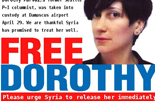The Living Textbook, funded out of JTM-Create or Die last June in Detroit, has recently received a two-year grant from the Ford Foundation to continue its work.
Co-directed by Emilia Askari and Joe Grimm, this project sponsored by the Asian American Journalists Association, is produced by seventh-grade students in Dearborn, Mich., who have a unique take on what it means to grow up Arab American in post-9/11 America. They are among the first generation of Americans to have no memory of what life was before the 2001 terrorist attacks.
The students’ photos and stories were created with a class of seventh graders at McCollough-Unis School. The idea was to help the students learn about journalism and capture stories about their Arab American community.
The students told stories about bullying and the school track team and the Detroit Tigers. They wrote and took photos about sitting down to big, American-style Thanksgiving dinners – with sides of hummus and tabouleh. Most of the kids are Muslim. Some of the girls, but not all, wear headscarves. Some wore green headscarves for St. Patrick’s Day and clipped shamrock antennae onto them. For USA Day, they wore red, white and blue.
For them, the Middle East is a local story. Most of the students’ families come from Lebanon, but the class also has students with ties to Kuwait and Syria. One boy labored over the story of the uprisings of the Arab Spring and what that is doing to his parents’ families in the Middle East. His mother stays up late at night to talk on the phone, losing sleep and weight. They live that story in their home here in the United States.
A video about the project was created by journalistic filmmaker Bill Kubota:
A photo exhibit of the students’ work opened on July 2, at the Arab American National Museum in Dearborn. The students would be thrilled if you left them a comment or two on their work. So check it out!
“It is our hope that these young storytellers will gain the skills and confidence they need to continue telling about their generation in words and pictures,” said project co-director Joe Grimm.
“We think that the digital literacy skills the students are learning will help them succeed – – in school, on the job and in their 21st century communities,” co-director Emilia Askari added.
Seeded by a small grant from Journalism That Matters-Create or Die, this project is funded by the McCormick Foundation and The Ford Foundation. Kodak, Target, and Costco have also donated in-kind products to support the program.
The project co-directors, Emilia Askari and Joe Grimm, have been working with the students weekly throughout the 2010-11 school years. Askari is a journalist, who just completed her master’s degree at the University Of Michigan School Of Information; she has spent about two decades as a reporter at newspapers such as the Detroit Free Press and the Miami Herald. Grimm is a professor at the Michigan State University School of Journalism and an adjunct faculty member with the Freedom Forum’s Diversity Institute; he previously worked for more than 30 years in newsrooms, spending a quarter-century at the Free Press.



